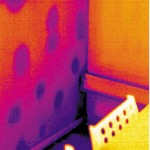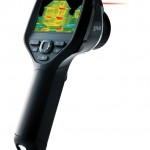Infrared cameras are great fun, and because the images they present seem easy to understand, some less experienced users can be drawn into making false conclusions – particularly if their knowledge of the application isn’t as deep as they think. This was definitely not the case at a seminar I gave earlier this week to members of the Property Care Association at their HQ in Huntingdon. This group of experts in surveying properties with problems associated with damp and moisture are at the top of their profession, and have looked at many technologies that could be suitable. It was really refreshing speaking with a group who were keen to understand whether thermal imaging really can do what it claims in their application, and could they get value for money from investing in the technology. A review of the day has been written up in Bryan Hindle’s blog

The main areas I covered were how to read a technical specification for an infrared camera to ensure you? ?understand what you are getting, and some of the applications infrared cameras have been used to help diagnose. Issues such as thermal bridging, flooding restoration and damp proofing are well known applications, there was a brief discussion about the use in mold growth applications – as the US market is largely driven by litigation risks for this application, which is an issue we don’t face here in the UK to anything like the same degree.
Fundamentally the price point of cameras with good performance for use in this market has now reached a  tipping point where many more practitioners can enter the market. The benefits of an infrared camera for building surveying and in particular problems with moisture is clear, and in the hands of a building engineer and moisture specialist, is an invaluable tool to add to their existing instrumentation. If you would like to review a range of suitable cameras click here, alternatively to contact us to discuss your requirements click here
tipping point where many more practitioners can enter the market. The benefits of an infrared camera for building surveying and in particular problems with moisture is clear, and in the hands of a building engineer and moisture specialist, is an invaluable tool to add to their existing instrumentation. If you would like to review a range of suitable cameras click here, alternatively to contact us to discuss your requirements click here
